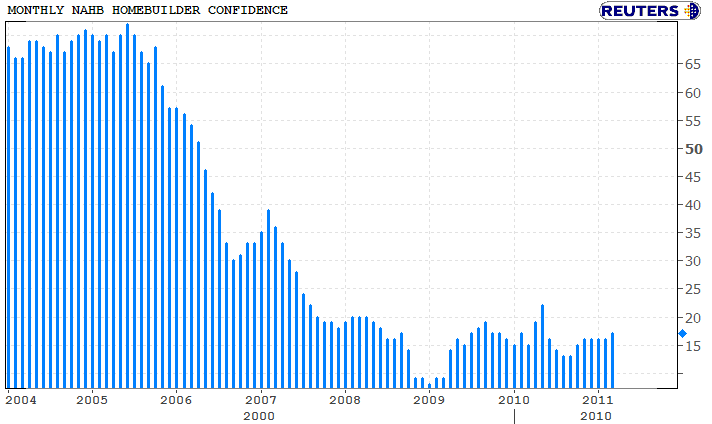For the first time in four months builders showed increased confidence in their responses to the National Association of Home Builders (NAHB)/Wells Fargo Housing Market Survey. The Housing Market Index (HMI) derived from that survey bumped up one point from its previously static position to 17 in March.
The Survey, which NAHB has conducted for over 20 years, asks builders to rate current single-family homes sales and their expectations for those sales in 6 months, both on a scale of "good," "fair," or "poor," and the traffic of prospective buyers as "high to very high," "average" or "low to very low." Each question results in a component score and the three components are used to calculate a seasonally adjusted index - the HMI - where any number over 50 indicates that more builders view sales conditions as good than poor.
This is the highest score for the HMI since May 2010, a time when builders were feeling the effects of the home buyer tax credit program.

The component gauging current sales conditions scored 17, unchanged from the previous month and the index measuring traffic of prospective buyers was 12, also unchanged. Builders, however, expressed optimism about sales in the next six months, driving that component to 27, the highest level since May 2010 and two points higher than the February figure.
"While many home buyers are still holding off on making a purchase, builders did indicate slightly increased optimism about the future with a two-point gain in the HMI component gauging sales expectations for the next six months," said NAHB Chief Economist David Crowe. "In fact, prevailing indicators portend some improvement in the overall economy, which should generate modest housing market gains later this year." But, he added, "Unfortunately, most small builders report that they are no more able to obtain credit for new construction today than they have been in the past year, and this is a major impediment that is keeping them from putting their crews back to work."
Regionally, HMI results were mixed in March. While the Northeast posted a one-point decline to 20, the Midwest held flat at 12, the South gained two points to 20 and the West gained four points to 17.







